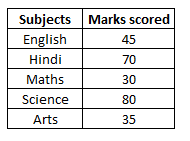1. Read the data in the table and answer the questions
 Five points are to be deducted from this students average of marks scored because of poor attendance. What will be this student's net average marks scored?
Five points are to be deducted from this students average of marks scored because of poor attendance. What will be this student's net average marks scored?
Show Similar Question And Answers
 Five points are to be deducted from this students average of marks scored because of poor attendance. What will be this student's net average marks scored? ....
Five points are to be deducted from this students average of marks scored because of poor attendance. What will be this student's net average marks scored? .... Powered By:Omega Web Solutions
Powered By:Omega Web Solutions